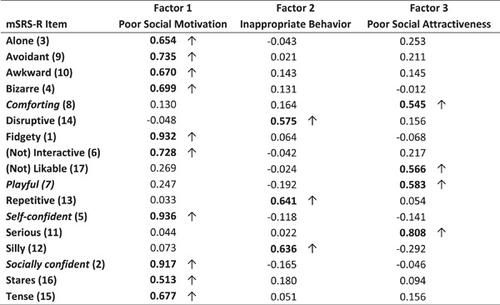当前位置:
X-MOL 学术
›
Am. J. Primatol.
›
论文详情
Our official English website, www.x-mol.net, welcomes your
feedback! (Note: you will need to create a separate account there.)
The factor structure of the macaque social responsiveness scale‐revised predicts social behavior and personality dimensions
American Journal of Primatology ( IF 2.0 ) Pub Date : 2021-02-02 , DOI: 10.1002/ajp.23234 Catherine F Talbot 1 , Alyssa C Maness 1, 2 , John P Capitanio 1, 2 , Karen J Parker 1, 3
American Journal of Primatology ( IF 2.0 ) Pub Date : 2021-02-02 , DOI: 10.1002/ajp.23234 Catherine F Talbot 1 , Alyssa C Maness 1, 2 , John P Capitanio 1, 2 , Karen J Parker 1, 3
Affiliation

|
Most primate species are highly social. Yet, within species, pronounced individual differences in social functioning are evident. In humans, the Social Responsiveness Scale (SRS) measures variation in social functioning. The SRS provides a quantitative measure of social functioning in natural social settings and can be used as a screening tool for autistic traits. The SRS was previously adapted for use in chimpanzees and recently refined for rhesus macaques, resulting in the macaque Social Responsiveness Scale‐Revised (mSRS‐R). Here, we performed an exploratory factor analysis on the mSRS‐R in a large sample of male rhesus macaques (N = 233). We investigated the relationships of the resulting mSRS‐R factors to quantitative social behavior (alone, proximity, contact, groom, and play) and to previously‐established personality dimensions (Sociability, Confidence, Irritability, and Equability). Factor analysis yielded three mSRS‐R factors: Poor Social Motivation, Poor Social Attractiveness, and Inappropriate Behavior. mSRS‐R factors mapped closely to social behavior and personality dimensions in rhesus macaques, providing support for this instrument's convergent and discriminant validity. Animals with higher Poor Social Motivation were more likely to be observed alone and less likely to be observed in contact and grooming with conspecifics. Animals with higher Poor Social Attractiveness were less likely to be observed playing but more likely to be observed grooming with conspecifics. Inappropriate Behavior did not predict any behavioral measure. Finally, animals with higher Poor Social Motivation and higher Poor Social Attractiveness had less sociable personalities, whereas animals with more Inappropriate Behavior were more confident and more irritable. These findings suggest that the mSRS‐R is a promising, psychometrically robust tool that can be deployed to better understand the psychological factors contributing to individual differences in macaque social functioning and, with relevant species‐specific modification, the SRS may hold promise for investigating variation in social functioning across diverse primate taxa.
中文翻译:

猕猴社会反应量表修订版的因子结构预测社会行为和人格维度
大多数灵长类动物都是高度社会化的。然而,在物种内部,社会功能的显着个体差异是显而易见的。在人类中,社会反应量表 (SRS) 衡量社会功能的变化。SRS 提供了自然社会环境中社会功能的定量测量,可用作自闭症特征的筛选工具。SRS 以前适用于黑猩猩,最近又针对恒河猴进行了改进,最终形成了猕猴社会反应量表修订版 (mSRS-R)。在这里,我们对大量雄性恒河猴 ( N = 233)。我们调查了由此产生的 mSRS-R 因素与定量社会行为(单独、接近、接触、新郎和玩耍)和先前建立的人格维度(社交性、信心、易怒和平等性)之间的关系。因子分析产生了三个 mSRS-R 因子:不良的社会动机、不良的社会吸引力和不当行为。mSRS-R 因素与恒河猴的社会行为和个性维度密切相关,为该工具的收敛效度和判别效度提供了支持。社会动机较差的动物更有可能被单独观察到,而在与同种动物接触和梳理时被观察到的可能性较小。社会吸引力较差的动物不太可能被观察到玩耍,但更有可能被观察到与同种动物一起梳理毛发。不当行为没有预测任何行为测量。最后,社会动机较差和社会吸引力较差的动物的社交性格较差,而行为不当的动物则更自信、更易怒。这些发现表明,mSRS-R 是一种很有前途的、心理测量学上强大的工具,可以用来更好地了解导致猕猴社会功能个体差异的心理因素,并且通过相关的物种特异性修改,SRS 有望用于调查变异在不同灵长类动物分类群的社会功能中。不当行为没有预测任何行为测量。最后,社会动机较差和社会吸引力较差的动物的社交性格较差,而行为不当的动物则更自信、更易怒。这些发现表明,mSRS-R 是一种很有前途的、心理测量学上强大的工具,可以用来更好地了解导致猕猴社会功能个体差异的心理因素,并且通过相关的物种特异性修改,SRS 有望用于调查变异在不同灵长类动物分类群的社会功能中。不当行为没有预测任何行为测量。最后,社会动机较差和社会吸引力较差的动物的社交性格较差,而行为不当的动物则更自信、更易怒。这些发现表明,mSRS-R 是一种很有前途的、心理测量学上强大的工具,可以用来更好地了解导致猕猴社会功能个体差异的心理因素,并且通过相关的物种特异性修改,SRS 有望用于调查变异在不同灵长类动物分类群的社会功能中。而行为不当的动物更自信,更易怒。这些发现表明,mSRS-R 是一种很有前途的、心理测量学上强大的工具,可以用来更好地了解导致猕猴社会功能个体差异的心理因素,并且通过相关的物种特异性修改,SRS 有望用于调查变异在不同灵长类动物分类群的社会功能中。而行为不当的动物更自信,更易怒。这些发现表明,mSRS-R 是一种很有前途的、心理测量学上强大的工具,可以用来更好地了解导致猕猴社会功能个体差异的心理因素,并且通过相关的物种特异性修改,SRS 有望用于调查变异在不同灵长类动物分类群的社会功能中。
更新日期:2021-02-02
中文翻译:

猕猴社会反应量表修订版的因子结构预测社会行为和人格维度
大多数灵长类动物都是高度社会化的。然而,在物种内部,社会功能的显着个体差异是显而易见的。在人类中,社会反应量表 (SRS) 衡量社会功能的变化。SRS 提供了自然社会环境中社会功能的定量测量,可用作自闭症特征的筛选工具。SRS 以前适用于黑猩猩,最近又针对恒河猴进行了改进,最终形成了猕猴社会反应量表修订版 (mSRS-R)。在这里,我们对大量雄性恒河猴 ( N = 233)。我们调查了由此产生的 mSRS-R 因素与定量社会行为(单独、接近、接触、新郎和玩耍)和先前建立的人格维度(社交性、信心、易怒和平等性)之间的关系。因子分析产生了三个 mSRS-R 因子:不良的社会动机、不良的社会吸引力和不当行为。mSRS-R 因素与恒河猴的社会行为和个性维度密切相关,为该工具的收敛效度和判别效度提供了支持。社会动机较差的动物更有可能被单独观察到,而在与同种动物接触和梳理时被观察到的可能性较小。社会吸引力较差的动物不太可能被观察到玩耍,但更有可能被观察到与同种动物一起梳理毛发。不当行为没有预测任何行为测量。最后,社会动机较差和社会吸引力较差的动物的社交性格较差,而行为不当的动物则更自信、更易怒。这些发现表明,mSRS-R 是一种很有前途的、心理测量学上强大的工具,可以用来更好地了解导致猕猴社会功能个体差异的心理因素,并且通过相关的物种特异性修改,SRS 有望用于调查变异在不同灵长类动物分类群的社会功能中。不当行为没有预测任何行为测量。最后,社会动机较差和社会吸引力较差的动物的社交性格较差,而行为不当的动物则更自信、更易怒。这些发现表明,mSRS-R 是一种很有前途的、心理测量学上强大的工具,可以用来更好地了解导致猕猴社会功能个体差异的心理因素,并且通过相关的物种特异性修改,SRS 有望用于调查变异在不同灵长类动物分类群的社会功能中。不当行为没有预测任何行为测量。最后,社会动机较差和社会吸引力较差的动物的社交性格较差,而行为不当的动物则更自信、更易怒。这些发现表明,mSRS-R 是一种很有前途的、心理测量学上强大的工具,可以用来更好地了解导致猕猴社会功能个体差异的心理因素,并且通过相关的物种特异性修改,SRS 有望用于调查变异在不同灵长类动物分类群的社会功能中。而行为不当的动物更自信,更易怒。这些发现表明,mSRS-R 是一种很有前途的、心理测量学上强大的工具,可以用来更好地了解导致猕猴社会功能个体差异的心理因素,并且通过相关的物种特异性修改,SRS 有望用于调查变异在不同灵长类动物分类群的社会功能中。而行为不当的动物更自信,更易怒。这些发现表明,mSRS-R 是一种很有前途的、心理测量学上强大的工具,可以用来更好地了解导致猕猴社会功能个体差异的心理因素,并且通过相关的物种特异性修改,SRS 有望用于调查变异在不同灵长类动物分类群的社会功能中。











































 京公网安备 11010802027423号
京公网安备 11010802027423号